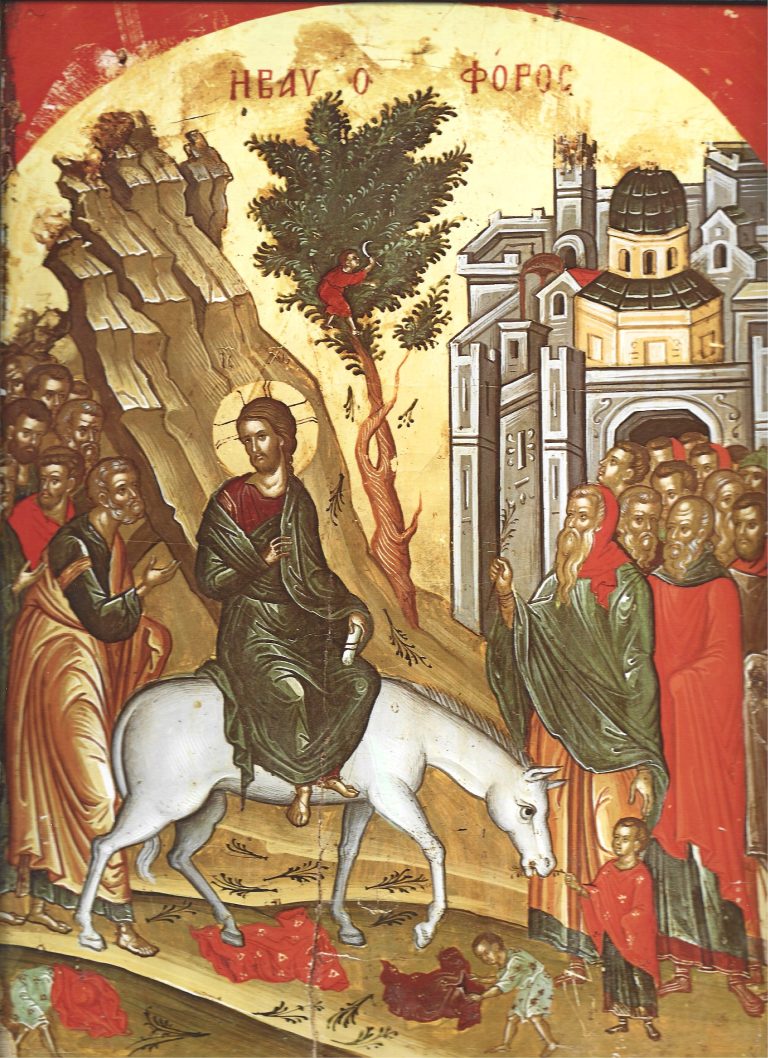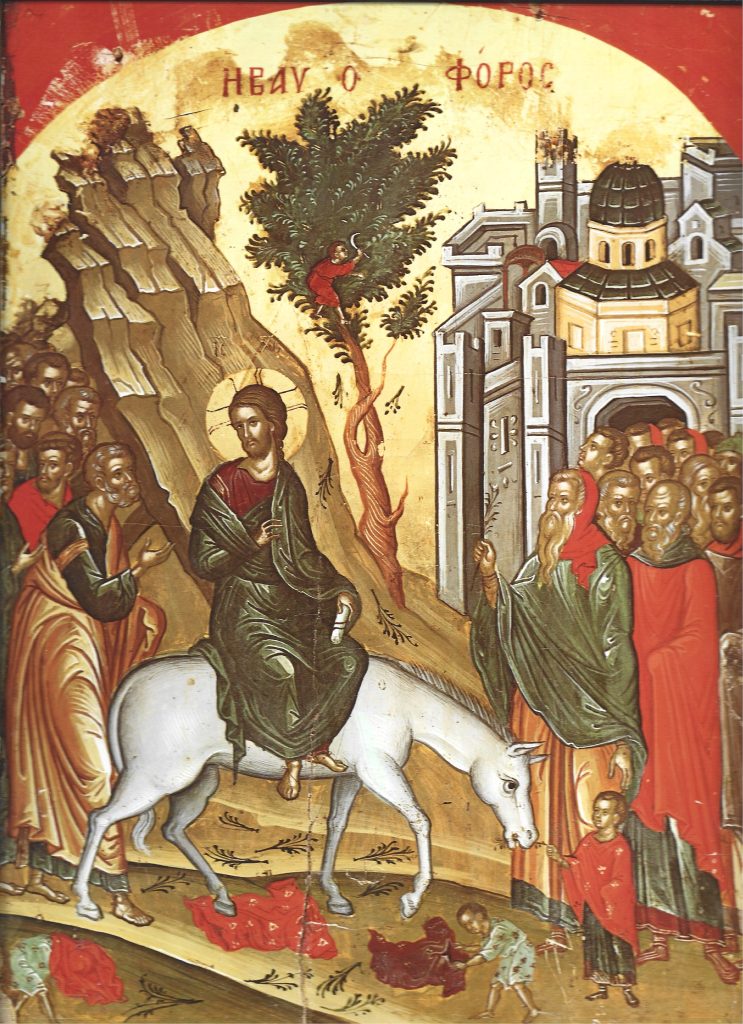

A Entrada em Jerusalém – Teófanes, o Cretano – A Montanha Sagrada (Grécia) – Sagrado Monastério de Stavronikita
A Entrada Triunfal de Jesus em Jerusalém – A Mística Cidade de Deus – Maria Agreda
Réplica na Igreja Nossa Senhora do Paraíso em São Paulo e no Museu Mítico
Lendo o ícone de Ramos
A mais antiga notícia da Festa da Entrada em Jerusalém (Ramos) nós a encontramos no Diário de Viagem da peregrina Egéria (c. 30-31), em Terra Santa.
Com o passar do tempo, vai adquirindo importância e solenidade a comemoração a ponto de no século VI já celebrar-se em quase todas as Igrejas orientais, enquanto, no Ocidente, seus primeiros vestígios datam de um século após, segundo Santo Isidoro de Sevilha (636).
Na vertical que idealmente passa pelo centro do Ícone, no primeiro plano aparece Cristo e uma palmeira, da qual as crianças estão cortando palmas para festejar o filho de Davi.
Somente Cristo porta auréola cruciforme na cabeça. Porque só Ele é o Santo.
Sua túnica purpúrea e Seu manto verde simbolizam Sua majestade: Sua humanidade (a púrpura) está envolvida por Sua divindade (o manto verde).
Ele aparece sentado no burrico de uma forma nada natural.
Parece estar em um trono carregado de tristeza e abrange a cidade e o povo que com ramos e palmas O acolhe alvoroçado. Tem na mão esquerda o rolo de nossas dívidas.
Sua direita está estendida, com o indicador, o médio e o mínimo retos: é o mistério da Trindade.
Os dois dedos reunidos recordam que em Cristo subsistem duas naturezas: a humana e a divina.
Atrás de Cristo sentado no burrico, aparece o grupo dos doze Apóstolos.
Pedro é o primeiro, reconhecível pela barba e cabelos crespos.
Perto dos Doze tem o Monte das Oliveiras, de onde desce Jesus para fazer Sua entrada em Jerusalém.
E ladeando o burrico, meninos, uns levando ramos, outros formando grupos, outro estendendo suas roupas, outros lançando ramos de palmas aos pés de Jesus.
O Domingo de Ramos é a Festa das crianças. E a iconografia não deixa de prestar-lhes atenção especial.
Fora da entrada da fortaleza (Cidade Santa), a multidão de homens e mulheres judeus levando nos braços os ramos, enquanto outros contemplam a Cristo.
Vimos que Jesus não entrou em Jerusalém em carruagem esplêndida, com o haviam feito todos os reis de Israel.
A esse Rei manso, montado em um burrico, invoca Romano, o Melode:
“Apieda-Te de Tuas criaturas por amor às quais Te dignaste habitar entre nós!”
Reading the icon of the Feast of the Entry into Jerusalem (Ramos)
We find the oldest news about the Feast of the Entry into Jerusalem (Ramos) in the Travel Diary of the pilgrim Egeria (c. 30-31), in the Holy Land.
Over time, the Nierolimitan commemoration acquired importance and solemnity to the point that in the 6th century it was already celebrated in almost all Eastern Churches, while, in the West, its first traces date from a century later, according to Saint Isidore of Seville (636).
In the vertical that ideally passes through the center of the Icon, in the foreground appears Christ and a palm tree, from which children are cutting palms to celebrate the son of David.
Only Christ wears a cruciform halo on his head. Because only He is the Holy One. His purple robe and green robe symbolize His majesty: His humanity (the purple) is enveloped by His divinity (the green robe).
He appears sitting on the donkey in an unnatural way. He seems to be on a throne filled with sadness and covers the city and the people who welcome Him with branches and palms in an uproar. In his left hand he holds the scroll of our debts.
His right is extended, with the index, middle and minimum straight: it is the mystery of the Trinity. The two fingers brought together remind us that in Christ two natures exist: the human and the divine.
Behind Christ sitting on the donkey, the group of twelve Apostles appears. Pedro is the first, recognizable by his beard and curly hair. Near the Twelve is the Mount of Olives, from where Jesus descends to enter Jerusalem.
And flanking the donkey, boys, some carrying branches, others forming groups, another spreading their clothes, others throwing palm branches at Jesus feet. Palm Sunday is the Feast of children. And the iconography does not fail to pay special attention to them.
Outside the entrance to the fortress (Holy City), the crowd of Jewish men and women carrying the branches in their arms, while others contemplate Christ.
We saw that Jesus did not enter Jerusalem in a splendid carriage, as all the kings of Israel had done.
To this meek King, riding on a donkey, invoke Romanus the Melode:
“Have mercy on Your creatures for the love of which You deigned to dwell among us!”
Source: G. Passarelli, The Icon of Entry into Jerusalem, 1996.
Produzido por / Directed by:
Consulte a Agenda do Museu a partir de 2025 e o visite quando receber sua confirmação de visita em seu email ou whatsapp.
Por se tratar de um museu particular, é necessário se cadastrar na Comunidade MuMi e customizar sua visita.
Criação e Tecnologia: Clayton Tenório @2025 MuMi – Museu Mítico